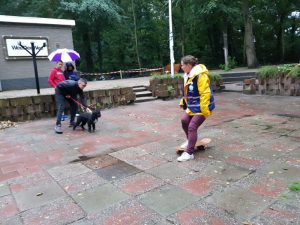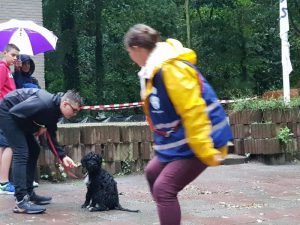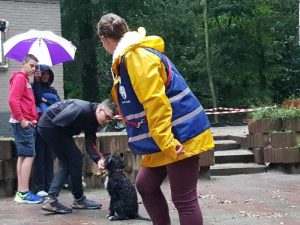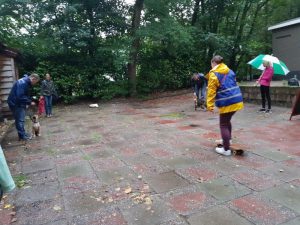[pictures shared with explicit owner permission]
‘Check!’ dog training exercise: the steps
The ‘check’ exercise features in nearly every puppy lesson at OhMyDog!, where we stage different real-life situations for the pups to learn to deal with.
When it’s been practised to death, it looks like this:
- You spot a horse/skateboard/moped/screaming child/fast cyclist/whatever has the potential to turn your dog into a hysterical mess (either in his enthousiasm or in through fear)
- You say ‘Check!’ to the dog in an enthousiastic voice
- The dog scans around to spot what you’re talking about. As soon as he has spotted the horse/skateboard/etc., you say ‘yes!’ and stick a treat in front of the dog’s nose
- You use the treat like a magnet for the dog’s nose, leading him into a u-turn a couple of meters further away from the horse/skateboard/etc. You could dive behind a tree or a car, cross the street, or whatever. We walk far enough that the horse is no longer in your dog’s mind. If you started at a sufficient distance, an extra couple meters should be enough.
- When you’re far enough, give the dog the treat. Give him/her the treat in a way that engages the dog’s brain. Keep it fun, surprising, playful. You could toss it in the grass, hide it under a leaf, etc. Get the dog really engaged in retrieving the treat, so the distraction is even further from his/her mind.
What’s the point of the ‘Check!’ dog training exercise?
Practice several times per day and your dog will soon see a passing cyclist/horse/etc. as a cue to look back at you and step away from the bicycle.
Congratulations: your dog has learnt to disengage from hyperfocus.
Your dog is now primed to view past-passing objects as a sign to re-engage with you, and to follow you away from the passing person.
You want to work on this exercise like mad with dogs who are obsessed with fast-passing objects like working line German Shepherds or Border Collies, or with scaredy cats: dogs who are scared of unfamiliar, fast.
When dog training can make things worse
Important subtlety: do NOT wait until your dog is hyperfocused on the distraction to practice this. When you first start, do this at such a distance from the trigger that you doubt the dog has even spotted it.
If your dog is so ‘magnetized’ by it that he can’t be distracted away from it, you’re actually making things worse. You’re entrenching the habit deeper.
What’s the difference with the “Watch Me” exercise?
“Watch Me” = “Look at me” vs. “Check!” = “Look at that”
We recommend the “Watch me” as a quick and dirty trick to get you out of a sticky situation: you ask the dog to fix his gaze on you and ignore the fast-passing object. The dog is not getting used to it, but you have a handle on the dog in a pinch.
If you notice that the dog is developing an unhealthy focus for something in particular (be that out of fear, predatory interest or social over-excitement), then it’s worth getting your dog to learn that that particular distraction is a trigger for engaging with you, not the passing object/animal/person.
What do skateboards have to do with it?
We like to practice this exercise with all sorts of objects, from someone wearing a motorcycle helmet to a jogger to, yes, someone on a skateboard.
This is me last week. Note how, on one of the pictures, the dog is hyperfocusing. This is a sign that the distance to the object is too small.




